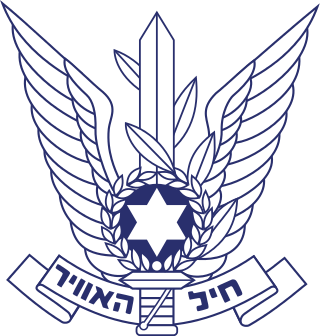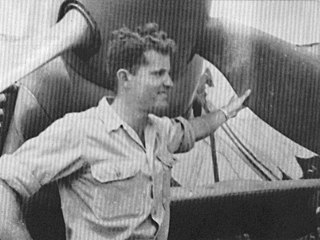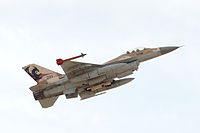
The Israeli Air Force operates as the aerial warfare branch of the Israel Defense Forces (IDF). It was founded on May 28, 1948, shortly after the Israeli Declaration of Independence. As of April 2022, Aluf Tomer Bar has been serving as the Air Force commander.

The Douglas A-4 Skyhawk is a single-seat subsonic carrier-capable light attack aircraft designed and produced by the American aerospace manufacturer Douglas Aircraft Company, and later, McDonnell Douglas. It was originally designated A4D under the United States Navy's pre-1962 designation system.

The 69 "Hammers" Squadron is an Israeli Air Force squadron operating the F-15I Thunder out of Hatzerim. It was formed in July 1948 to operate three B-17 Flying Fortresses which the fledgling Israeli Air Force had acquired in the United States. The squadron flew the Flying Fortress, an aircraft credited with propelling the IAF into the realm of modern aerial warfare, during both the 1948 Arab–Israeli War and 1956 Suez Crisis. Disbanded in early 1957, 69 Squadron reformed in 1969 to fly the F-4 Phantom II.

The Dassault MD.454 Mystère IV is a 1950s French fighter-bomber aircraft, the first transonic aircraft to enter service with the French Air Force. It was used in large-scale combat in the Israeli Air Force during the 1967 Six Day War.
Operation Boxer was an aerial offensive undertaken by the Israeli Air Force along the Suez Canal in July 1969. The first major IAF operation since the 1967 Six-Day War, the operation signaled a new phase in the War of Attrition.

The 178th Wing is a unit of the Ohio Air National Guard, stationed at the Springfield-Beckley Municipal Airport ANG complex, Springfield, Ohio. If activated to federal service, the wing is gained by the United States Air Force Air Combat Command (ACC), with elements of the wing gained by the Air Force Intelligence, Surveillance and Reconnaissance Agency (AFISRA).
Bir Gifgafa is an airfield in the Sinai, 90 km east of the Suez Canal. During the 1960s and 1970s it played a significant role in Arab–Israeli wars, at different times serving both Egypt and Israel.
Rimon 20 was the code name of an aerial battle in 1970 which pitted the Israeli Air Force directly against Soviet fighter pilots stationed in Egypt during the War of Attrition. Israel planned the dogfight in order to send a message that it would no longer tolerate direct Soviet military involvement in its conflict with Egypt.

Operation Raviv, also known in Egypt as the Zaafarana accident or the Ten-Hour War, was a mounted raid conducted by the Israeli Defence Forces (IDF) on Egypt's Red Sea coast during the War of Attrition. Taking place on September 9, 1969, Raviv was the sole major ground offensive undertaken by the IDF against Egypt throughout the war. The operation saw Israeli forces masquerading as Egyptian troops and using captured Arab armor.

Giora Romm was an Israeli military officer who served as deputy commander of the Israeli Air Force (IAF), Israel's military attaché in the United States and as director of the Civil Aviation Authority of Israel. Romm was the IAF's first jet ace, scoring five kills during the 1967 Six-Day War. In 1969, during the War of Attrition, Romm was shot down and spent several months in Egyptian captivity. He commanded the IAF's 115 Squadron through the intensive fighting of the 1973 Yom Kippur War and participated in Operation Wooden Leg, the 1985 raid against PLO headquarters in Tunisia.

Amir Nachumi is a retired Israeli Air Force Brigadier General who, in the course of his career, shot down 14 enemy aircraft, making him one of Israel's top flying aces. He scored 7 aerial kills in the F-4 Phantom II during the Yom Kippur War, 7 in the F-16 Fighting Falcon in fighting over Lebanon, and participated in Operation Opera, the 1981 raid that destroyed an Iraqi nuclear reactor.

In May 1983, two Israeli Air Force aircraft, an F-15 Eagle and an A-4 Skyhawk, collided in mid-air during a training exercise over the Negev region, in Israel. Notably, the F-15,, managed to land safely at a nearby airbase, despite having its right wing almost completely sheared off in the collision. The lifting body properties of the F-15, together with its overabundant engine thrust, allowed the pilot to achieve this unique feat.

Mordechai "Modi" Alon was an Israeli fighter pilot who with the formation of the Israeli Air Force in May 1948, assumed command of its first fighter squadron. Flying the Avia S-199, Alon participated in the IAF's first combat sortie on 29 May 1948, and on 3 June scored the IAF's very first aerial victories, downing a pair of Royal Egyptian Air Force C-47s over Tel Aviv.

147 Squadron, often referred to as the Flying Ibex or Goring Ram squadron, is a former unit of the Israeli Air Force. Fielding IAF Flight Academy aircraft, it flew the Boeing-Stearman Kaydet during the 1956 Suez Crisis and the Fouga Magister during the 1967 Six-Day War, in the course of which it suffered six fatalities. Between 1978 and 1986 it flew the A-4 Skyhawk.

The Galilee Squadron was an aerial unit established by the Yeshuv during the 1948 Arab-Israeli War to assist the Jewish war effort in northern Palestine. Initially a part of the Sherut Avir, the aerial arm of the Haganah, it was absorbed into the fledgling Israeli Air Force (IAF) upon the latter's formation on 28 May 1948. The unit served throughout the war, following which it was amalgamated with several other units to form the IAF's 100 Squadron.

The History of the Israel Air Force begins in May 1948, shortly after the formation of the State of Israel. Following Israel's declaration of independence on May 14, its pre-state national institutions transformed into the agencies of a state, and on May 26, 1948, the Israeli Air Force was formed. Beginning with a small collection of light aircraft, the force soon transformed into a comprehensive fighting force. It has since participated in several wars and numerous engagements, becoming what has been described as "The mightiest air force in the Middle East".
149 Squadron, often referred to as the Smashing or Shattering Parrot squadron is a former unit of the Israeli Air Force. Active from 1976 to 1991, the squadron flew the A-4 Skyhawk and IAI Kfir.

Ran Goren is a retired fighter pilot and Major General of the IDF, former Deputy Commander of the Air Force and Head of the Manpower Directorate.

Rami Harpaz was a colonel in the Israel Defence Forces and a prisoner of war during the War of Attrition. Harpaz served as a fighter pilot in the Israeli Air Force (IAF) and spent three and a half years in an Egyptian prison. Following his release, he returned to the Air Force, and came to command the IAF base at Ramat David.


















